2.05.2017
James Webb Space Telescope will soon leave NASA Goddard for next phase of testing
The James Webb Telescope is ready to leave the NASA Goddard Space Flight Center— where the core of the observatory was constructed — and move on to the next phase in its journey to space.
NASA officials said Monday that Webb, the successor to the Hubble Space Telescope, has passed the last of its tests at the Greenbelt facility.
It will soon be shipped to the NASA Johnson Space Center in Houston for its next round of testing.
"The Webb telescope is about to embark on its next step in reaching the stars as it has successfully completed its integration and testing at Goddard," Bill Ochs, NASA's Webb telescope project manager, said in a statement. "It is also a sad time as we say goodbye to the Webb Telescope at Goddard, but are excited to begin cryogenic testing at Johnson."
The telescope has been in development, construction and assembly process for two decades, and its mirror and instruments have come together in a massive clean room at Goddard just over the past several years.
It is designed to see farther into space, and with greater sensitivity to light, than the Hubble. Its observations are expected to revolutionize understanding of the early universe, just as Hubble did starting in the 1990s, and to explore distant Earth-like planets in ways Hubble cannot.
The telescope's observatory, including its 21-foot mirror and set of four science instruments, spent months facing a battery of tests designed to show it can withstand the violent vibrations and loud sounds it will experience when it's launched next year.
Now, it will be tested in a large cryochamber at the Johnson center to prove it can operate in the chill of space.
NASA officials would not say when the move to Houston will occur, citing security concerns.
From there, the observatory is headed for Northrop Grumman Aerospace Systems in Redondo Beach, Calif., where it will be integrated with its six-layer sun shield that protects the instruments and mirror from interference.
It will travel by barge from California, through the Panama Canal, to French Guiana on the northern coast of South America, for its launch, slated for next October. The European Space Agency has a space port there.
Quelle: THE BALTIMORE SUN
+++
NASA’s James Webb Space Telescope has successfully passed the center of curvature test, an important optical measurement of Webb’s fully assembled primary mirror prior to cryogenic testing, and the last test held at NASA's Goddard Space Flight Center in Greenbelt, Maryland, before the spacecraft is shipped to NASA’s Johnson Space Center in Houston for more testing.
After undergoing rigorous environmental tests simulating the stresses of its rocket launch, the Webb telescope team at Goddard analyzed the results from this critical optical test and compared it to the pre-test measurements. The team concluded that the mirrors passed the test with the optical system unscathed.
“The Webb telescope is about to embark on its next step in reaching the stars as it has successfully completed its integration and testing at Goddard. It has taken a tremendous team of talented individuals to get to this point from all across NASA, our industry and international partners, and academia,” said Bill Ochs, NASA’s Webb telescope project manager. “It is also a sad time as we say goodbye to the Webb Telescope at Goddard, but are excited to begin cryogenic testing at Johnson.”
Rocket launches create high levels of vibration and noise that rattle spacecraft and telescopes. At Goddard, engineers tested the Webb telescope in vibration and acoustics test facilities that simulate the launch environment to ensure that functionality is not impaired by the rigorous ride on a rocket into space.
Before and after these environmental tests took place, optical engineers set up an interferometer, the main device used to measure the shape of the Webb telescope’s mirror. An interferometer gets its name from the process of recording and measuring the ripple patterns that result when different beams of light mix and their waves combine or “interfere.”
Waves of visible light are less than a thousandth of a millimeter long and optics on the Webb telescope need to be shaped and aligned even more accurately than that to work correctly. Making measurements of the mirror shape and position by lasers prevents physical contact and damage (scratches to the mirror). So, scientists use wavelengths of light to make tiny measurements. By measuring light reflected off the optics using an interferometer, they are able to measure extremely small changes in shape or position that may occur after exposing the mirror to a simulated launch or temperatures that simulate the subfreezing environment of space.
During a test conducted by a team from Goddard, Ball Aerospace of Boulder, Colorado, and the Space Telescope Science Institute in Baltimore, temperature and humidity conditions in the clean room were kept incredibly stable to minimize fluctuations in the sensitive optical measurements over time. Even so, tiny vibrations are ever-present in the clean room that cause jitter during measurements, so the interferometer is a “high-speed” one, taking 5,000 “frames” every second, which is a faster rate than the background vibrations themselves. This allows engineers to subtract out jitter and get good, clean results on any changes to the mirror's shape.
“Some people thought it would not be possible to measure beryllium mirrors of this size and complexity in a clean room to these levels but the team was incredibly ingenious in how they performed these measurements and the results give us great confidence we have a fantastic primary mirror,” said Lee Feinberg, Webb’s telescope optical element manager.
The Webb telescope will be shipped to Johnson for end-to-end optical testing in a vacuum at its extremely cold operating temperatures. Then it will continue on its journey to Northrop Grumman Aerospace Systems in Redondo Beach, California, for final assembly and testing prior to launch in 2018.
Quelle: NASA
---
Update: 8.05.2017
.
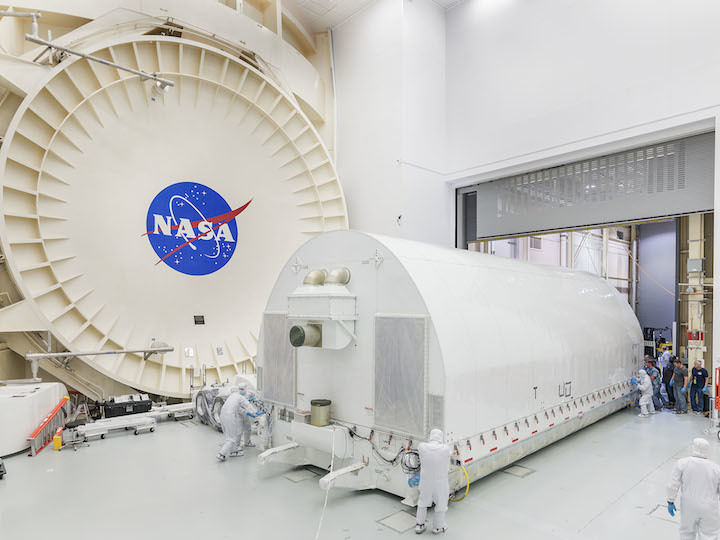
NASA's James Webb Space Telescope has arrived at NASA’s Johnson Space Center in Houston, Texas, where it will undergo its last cryogenic test before it is launched into space in 2018.
The telescope was loaded onto a trailer truck from NASA’s Goddard Space Flight Center in Greenbelt, Maryland, and moved slowly down a highway by the Webb team to Joint Base Andrews in Maryland. At Andrews, the entire tractor-trailer, with telescope inside, was driven into a U.S. Air Force C-5C aircraft and flown to Ellington Field in Houston, Texas.
When the C-5 landed at Ellington, the cargo was carefully unloaded and trucked to NASA Johnson, where inside a cleanroom the telescope was removed from its special shipping container. In the coming weeks it will be prepared for a key cryogenic test that will run nearly 100 days.
To ensure the telescope's optics will operate at its frigid destination 1 million miles out in space, it must complete tests at cryogenic temperatures in a vacuum. The biggest and final cryogenic-vacuum test occurs in Johnson's Chamber A, the same vacuum chamber where Apollo spacecraft were tested. This test is critical in that it will verify the performance of the whole telescope as a system end-to-end at its extremely cold operating temperatures. Subsequently, the telescope will continue on its journey to Northrop Grumman Aerospace Systems in Redondo Beach, California, for final assembly and testing with the spacecraft bus and sunshield prior to launch in 2018.
The James Webb Space Telescope is the world’s most advanced space observatory. This engineering marvel is designed to unravel some of the greatest mysteries of the universe, from discovering the first stars and galaxies that formed after the big bang to studying the atmospheres of planets around other stars. It is a joint project of NASA, ESA (the European Space Agency) and the Canadian Space Agency.
Quelle: NASA
---
Update: 10.05.2017
.
Two James Webb instruments are best suited for exoplanet atmospheres
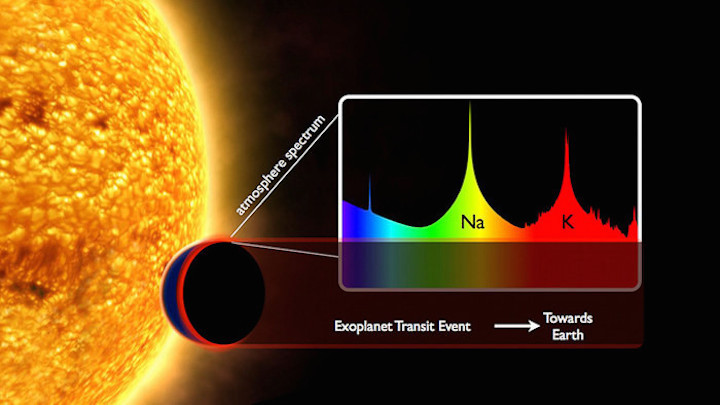
UNIVERSITY PARK, Pa. — The best way to study the atmospheres of distant worlds with the James Webb Space Telescope, scheduled to launch in late 2018 will combine two of its infrared instruments, according to a team of astronomers.
"We wanted to know which combination of observing modes (of Webb) gets you the maximum information content for the minimum cost," says Natasha Batalha, graduate student in astronomy and astrophysics and astrobiology, Penn State, and lead scientist on this project. "Information content is the total amount of information we can get from a planet's atmospheric spectrum, from temperature and composition of the gas — like water and carbon dioxide — to atmospheric pressures."
Batalha and Michael Line, assistant professor, School of Earth and Space Science, Arizona State University, developed a mathematical model to predict the quantity of information that different Webb instruments could extract about an exoplanet's atmosphere.
Their model predicts that using a combination of two infrared instruments — the Near Infrared Imager and Slitless Spectrograph (NIRISS) and the G395 mode on the Near Infrared Spectrograph (NIRSpec) — will provide the highest information content about an exoplanet's atmosphere.
NIRISS is a versatile camera and spectrograph that will observe infrared wavelengths similar to those the Hubble Telescope covers. NIRISS, according to Batalha and Line, should be combined with the G395 mode on NIRSpec, which will observe targets in longer infrared wavelengths at Webb's highest resolution.
Three main characteristics affect how much information an instrument can extract — resolution, maximum observable brightness, and wavelength range. These combined determine the total observable fraction of the information content of a planet's atmospheric spectrum.
Both NIRISS and NIRSpec will observe near-infrared wavelengths, the region of the electromagnetic spectrum in which the stars that exoplanets orbit around shine brightest. NIRISS is poised to measure a strong signature of water and NIRSpec can do the same for methane and carbon dioxide, three chemical compounds that provide a substantial amount of information about an atmosphere.
Batalha and Line tested each of ten likely observing methods on its own and in every possible combination with the other methods to determine which would maximize the total information content.
They retrieved the information from a set of simulated planets with temperatures and compositions that cover the range of previously observed exoplanet atmospheres. By comparing the retrievable information content in each planet's atmosphere, Batalha and Line found that this one combination of NIRISS and NIRSpec modes gives the most information regardless of the exoplanet's temperature or composition. The researchers published these results in The Astronomical Journal.
"We won't know a planet's temperature ahead of time," says Batalha. "If you're going to do a shot in the dark observation, you have the greatest chance of getting the information you want with this combination of instruments."
As an exoplanet crosses between its host star and Earth's telescopes, some of the star's light passes through the exoplanet's atmosphere. The exo-atmosphere leaves its fingerprint in the star's light — the planet's transmission spectrum — from which astronomers can learn about the exo-atmosphere's temperature, chemical composition and structure. The researchers' information content analysis focuses on the information retrievable from the transmission spectrum of a planet.
While Webb will not launch until late 2018, but astronomers are already planning the first set of observations they would like from the telescope.
"If we can strategize now," says Batalha, "by the time the first cycle of formal proposals comes around we can ensure that we are picking the best modes for larger proposals and not waste valuable observing time. This way everyone starts on an even playing field with the science."
While they highlight two NIRISS and NIRSpec modes as the best combination for observing most exo-atmospheres, Batalha and Line explain that the other modes will still be useful to observe different features of exo-atmospheres that the astronomers have not tested for, like clouds, haze and atmospheres hot enough to emit their own light.
"In the future," Batalha says, "there will be a push to characterize the first Earth 2.0. If we don't nail this down now and master the art of characterizing exo-atmospheres, we will never accurately characterize Earth 2.0."
The National Science Foundation, the Kavli Summer Program in Astrophysics, the NASA Astrobiology Program Early Career Collaboration Award, and the NASA Hubble Fellowship supported this research.
Quelle: University Park, Pennsylvania
---
Update: 14.05.2017
.
James Webb Space Telescope moving forward – latest milestone for Airbus contributions to the mission
James Webb telescope and instrument module shipped by NASA from Goddard Space Flight Centre in Washington to Johnson Space Centre in Houston for final tests
 Houston 08/05/2017 – OTIS (Optical Telescope Element and Integrated Science), the payload module hosting the telescope and the instruments for the giant James Webb Space Telescope (JWST) has been shipped by NASA to the Johnson Space Centre (JSC) in Houston, Texas. OTIS includes two European instruments with major Airbus contributions, the near-infrared spectrograph NIRSpec built by Airbus and the mid-infrared instrument MIRI built with the support of Airbus.
Houston 08/05/2017 – OTIS (Optical Telescope Element and Integrated Science), the payload module hosting the telescope and the instruments for the giant James Webb Space Telescope (JWST) has been shipped by NASA to the Johnson Space Centre (JSC) in Houston, Texas. OTIS includes two European instruments with major Airbus contributions, the near-infrared spectrograph NIRSpec built by Airbus and the mid-infrared instrument MIRI built with the support of Airbus.
NIRSpec, weighing 200kg, will be able to detect the faintest radiation from the most distant galaxies, observing more than 100 of them simultaneously. It will observe large samples of galaxies and stars at unprecedented depths across large swathes of the Universe and far back in time. Once launched, NIRSpec, known as the ‘super eye’, will operate at a temperature of -238°C. The instrument was developed by Airbus for the European Space Agency (ESA).
The MIRI instrument is a combined camera, spectrograph and coronagraph for mid-infrared wavelengths that will extend JWST’s observation capabilities to longer wavelengths, vital for the study of light from objects in the early universe or to peer inside dust clouds where stars and planetary systems are forming today. MIRI was developed by a European consortium of 21 institutes from 10 ESA member states as well as NASA’s Jet Propulsion Laboratory and Goddard Space Flight Centre, led by the UK’s Astronomy Technology Centre with project management from Airbus.

“This is a fantastic next step for the James Webb Space Telescope – bringing it one step closer to launch on Ariane 5,” said Nicolas Chamussy, Head of Space Systems. “JWST will enable us to study the early Universe and peer inside dust clouds to study star formation. This spacecraft represents the pinnacle of technology for modern astronomy, and shows Airbus’ outstanding expertise in support of the scientific research that JWST will carry out.”
NASA, ESA, and the Canadian Space Agency (CSA) are collaborating to develop JWST, designed to be the next step after the legendary Hubble Space Telescope. After its launch in 2018 on an Ariane 5 launcher from Europe’s spaceport in Kourou, French Guiana, JWST will be the largest astronomical telescope in space. It will be able to study key phases in the evolution of the Universe in great detail – from the formation of the first stars and galaxies only a few hundred millions years after the Big Bang to the formation of planetary systems in our own Milky Way galaxy today.
Quelle: Airbus
---
Update: 22.06.2017
.
NASA's special "Webb-cam" kept an eye on the development of NASA's James Webb Space Telescope at NASA's Goddard Space Flight Center in Greenbelt, Maryland, since 2012. Now that Webb telescope has moved to NASA's Johnson Space Center in Houston, Texas, a special Webb camera was installed there to continue providing daily video feeds on the telescope's progress.
Space enthusiasts, who are fascinated to see how this next generation space telescope has come together and how it is being tested, are able to see the telescope’s progress as it happens by watching the Webb-cam feed online.
There were two Webb-cams at NASA Goddard. Those cameras, which were mounted inside the giant cleanroom, provided still photos (refreshed every minute) of the activity inside and gave a peek at what engineers and technicians were doing to the telescope as it came together. Over the last five years, Webb-cam viewers saw some amazing images of the Webb at Goddard, such as when all 18 gold-coated mirror segments of the Webb's primary mirror were mounted on the telescope.
"The two Webb-cams we installed in Goddard's giant cleanroom have developed a huge following over the last five years," said Maggie Masetti, social media manager and web developer on the Webb telescope mission at NASA Goddard. "With millions of views every month, you can bet that if there was a camera glitch, we heard about it right away."
The new "Webb-cam" is mounted where it has a view of the cleanroom at NASA Johnson Space Center. The camera fronts the chamber where the Webb telescope will be undergoing cryogenic testing in a massive chamber called "Chamber A." Although there is no view of Webb once it is inside the chamber during the actual cryo-optical testing, there will be much activity on Webb in the cleanroom itself for several weeks before and after.
The Web camera at NASA’s Johnson Space Center can be seen online at: http://jwst.nasa.gov/, with larger views of the cams available at: http://jwst.nasa.gov/webcam.html.
The James Webb Space Telescope is the scientific successor to NASA's Hubble Space Telescope. It will be the most powerful space telescope ever built. Webb is an international project led by NASA with its partners, ESA (European Space Agency) and CSA (Canadian Space Agency).
+++
NASA’s James Webb Space Telescope was placed in Johnson Space Center’s historic Chamber A on June 20, 2017, to prepare for its final three months of testing in a cryogenic vacuum that mimics temperatures in space.
Engineers will perform the test to prove that the telescope can operate in space at these temperatures. Chamber A will simulate an environment where the telescope will experience extreme cold -- around 37 Kelvin (minus 236 degrees Celsius or minus 393 degrees Fahrenheit).
In space, the telescope must be kept extremely cold, in order to be able to detect the infrared light from very faint, distant objects. To protect the telescope from external sources of light and heat (like the sun, Earth, and moon), as well as from heat emitted by the observatory, a five-layer, tennis court-sized sunshield acts like a parasol that provides shade. The sunshield separates the observatory into a warm, sun-facing side (reaching temperatures close to 400 degrees Fahrenheit) and a cold side (185 degrees below zero). The sunshield blocks sunlight from interfering with the sensitive telescope instruments.
The James Webb Space Telescope is the scientific successor to NASA's Hubble Space Telescope. It will be the most powerful space telescope ever built. Webb is an international project led by NASA with its partners, ESA (European Space Agency) and the Canadian Space Agency.
Quelle: NASA
---
Update: 10.08.2017
.
James Webb: Telescope's giant origami shield takes shape
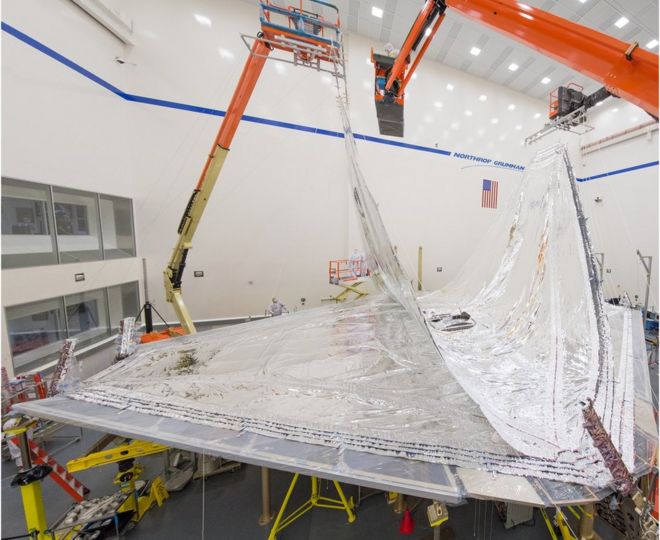 Image copyrightNORTHROP GRUMMAN CORP
Image copyrightNORTHROP GRUMMAN CORP
It is the size of a tennis court and next year it will go into orbit as part of the most sophisticated space telescope ever built.
The kite-shaped object is a mask that will protect the James Webb observatory from the glare and heat of the Sun as it tries to image the deep Universe.
Engineers have just finished joining together its individual layers.
These membranes, made from a polymer material known as kapton, are as thin as a human hair.
In their shade, the Webb telescope should be able to reach its operating temperature of less than 50 degrees above absolute zero (-223C).
- Swallowing the biggest space telescope
- James Webb's mirror is revealed
- Hubble successor maintains course
- Hubble's star refuses to fade
The finished shield is too big to fit in a rocket, however - as is the James Webb telescope.
Observatory and shield must therefore be folded up on themselves, origami style, for the ride to orbit. Only when they get into space can they be unpacked into an operational configuration.
 Image copyrightNASA/C.GUNN
Image copyrightNASA/C.GUNN
The Northrop Grumman Corporation in Redondo Beach, California, which leads the industrial consortium on the project, is currently packing and stowing the membranes ahead of deployment tests that will take place later this month.
Assuming all goes to plan, the shield will then be attached to Webb's foldable mirrors and instruments.
These elements are due arrive at Redondo Beach later in the year.
They are presently in tests of their own at the US space agency's Johnson centre in Texas. These investigations aim to ensure the telescope can focus and analyse light properly.
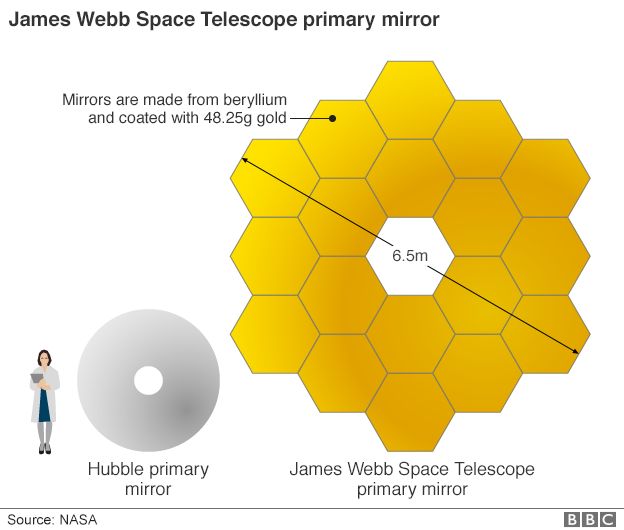
James Webb is often described as the successor to the Hubble Space Telescope which is nearing the end of its mission life.
The obvious difference is that Webb is much bigger. Its main mirror is 6.5m across versus Hubble's 2.3m. But the new observatory will also be working at longer wavelengths of light compared with its predecessor.
Webb will sense in the near and mid-infrared range of the electromagnetic spectrum. This should allow the telescope to look deeper into space than Hubble, to see the very first stars to ignite in the cosmos more than 13 billion years ago.
The James Webb Space Telescope is a joint endeavour of Nasa, and the European and Canadian space agencies. Its launch on a European Ariane rocket is currently scheduled for October 2018.
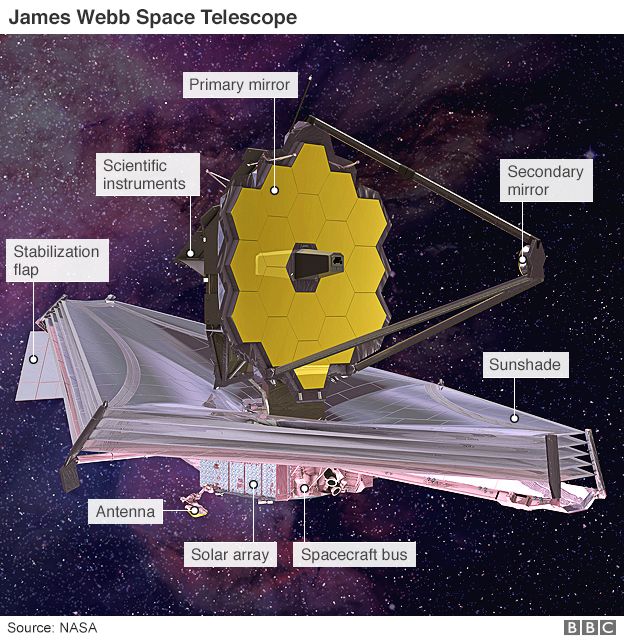
Quelle: BBC
+++
NASA's James Webb Space Telescope began a nearly 100-day cryogenic test in a giant chamber in Texas in mid-July. Components of the Webb have previously endured similar tests to ensure they would function in the cold environment of space. Now all of those components are being tested together in the giant thermal vacuum known as Chamber Aat NASA's Johnson Space Center in Houston.
"A combination of liquid nitrogen and cold gaseous helium will be used to cool the telescope and science instruments to their operational temperature during high-vacuum operations," said Mark Voyton, manager of testing effort, who works at the NASA Goddard Space Flight Center in Greenbelt, Maryland.
Next year, the tennis-court sized sunshield and spacecraft bus will be added to make up the entire observatory.
Previous Testing
In early 2016, the science instruments completed a series of similar cryogenic testing at NASA Goddard. For months, the components were tested inside the Space Environment Simulator.
Then, a "practice model" known as the “Pathfinder” telescope endured similar testing in Chamber A. The test confirmed that the real or flight Webb telescope could be done. NASA often rehearses with practice models to ensure all complicated test equipment works and that the precision-test conditions are achievable before subjecting an actual flight article to testing.
In early March 2017 at NASA Goddard, Webb’s mirrors and instruments successfully concluded vibration and acoustic environmental testing. Those tests ensured Webb can withstand the vibration and noise created during the telescope's launch into space. Currently, engineers are analyzing this data to prepare for a final round of vibration and acoustic testing, once Webb is joined with the spacecraft bus and sunshield next year.
In May 2017, Webb journeyed to NASA Johnson, taking Pathfinder’s place inside the historic vacuum chamber, Chamber A.
How and What Chamber A Will Do?
Vacuum pumps remove nearly 100% of the air from the chamber. Temperatures are cooled in Chamber A by coursing liquid nitrogen and cold gaseous helium through plumbing on the shrouds, which act as heat exchangers. That process drops the temperatures in the chamber to simulate conditions in space where the Webb telescope will orbit. "Of course the chamber stays under vacuum and the cryogens are flowed through the shroud plumbing to radiatively cool everything inside the chamber," said Paul Geithner, Webb’s deputy project manager - technical of NASA Goddard.
The testing is critical because these instruments must operate at around minus 387 Fahrenheit (minus 232.8 degrees Celsius or 40 Kelvin). This is 260 Fahrenheit (126.7 degrees Celsius) colder than any temperature ever recorded on Earth’s surface.
In Chamber A, the telescope will be cooled down so temperatures are steady and change very little with time, and then warmed up to room temperature or “ambient” conditions.
SIDEBAR FEATURE: How Does NASA’s Webb Telescope Stay Cool in Chamber A?
Monitoring the Testing
During the testing period, scientists and engineers will monitor the telescope with temperature sensors and cameras in Chamber A.
"As far as monitoring goes, there are many thermal sensors that monitor temperatures of the telescope and the support equipment," said Gary Matthews, an engineer on the Webb telescope at Goddard. "We also have some specialized camera systems that allow us to know the physical position of the hardware inside the chamber. That allows us to monitor how the Webb moves as it gets colder. Finally, there is a whole host of optical equipment that we will use to understand the performance of the telescope."
What's Next After Chamber A?
Once the end-to-end cryo-optical testing is complete at NASA Johnson this fall, the telescope will journey to Northrop Grumman in Redondo Beach, California, where it will be integrated with the spacecraft and sunshield, thus forming the James Webb Space Telescope observatory. Once there, it will undergo more tests called "observatory-level testing." This testing is the last exposure to a simulated launch environment before flight and deployment testing on the whole observatory.
The James Webb Space Telescope is the world’s most advanced space observatory. This engineering marvel is designed to unravel some of the greatest mysteries of the universe, from discovering the first stars and galaxies that formed after the big bang to studying the atmospheres of planets around other stars. It is a joint project of NASA, the European Space Agency (ESA) and the Canadian Space Agency (CSA).
Quelle: NASA
---
Update: 11.08.2017
.
Webb Telescope's Critical Protective Sunshield Now Fully Installed
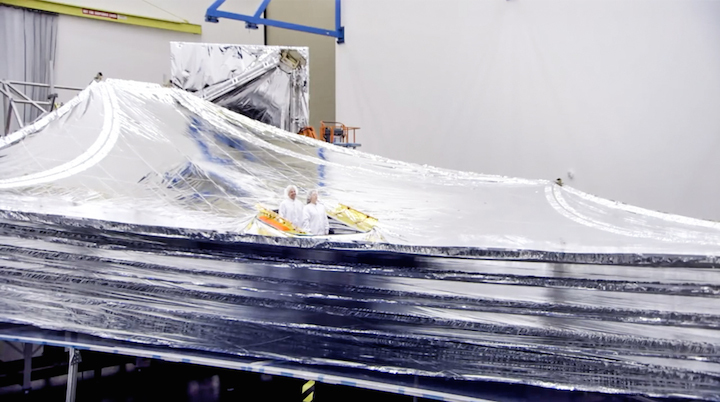
A piece of hardware critical to the success of the James Webb Space Telescope (JWST) by preventing background heat from the Sun, Earth and Moon from interfering with the telescope’s sensitive infrared instruments is now fully installed, completed at Northrop Grumman Aerospace Systems in Redondo Beach, California earlier this week.
Quelle: AS







